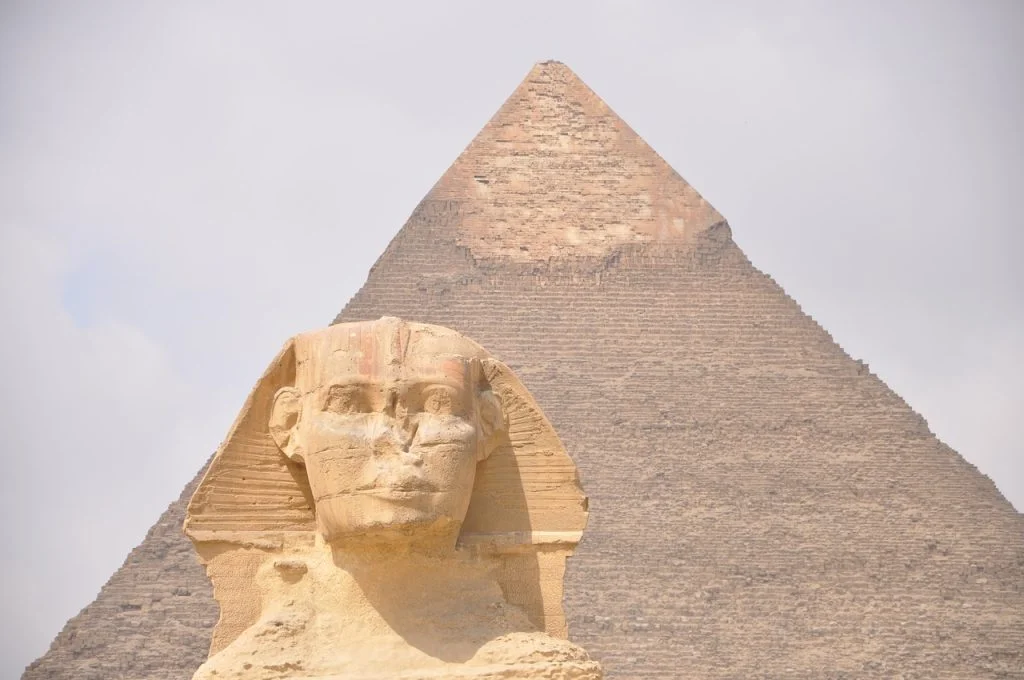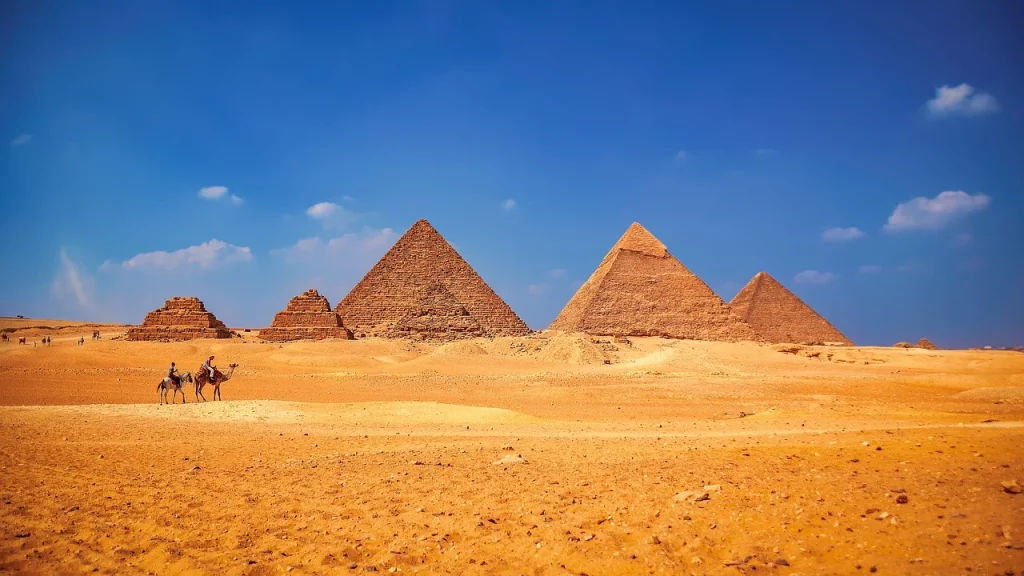Ever had a pyramid-shaped cake? Well, my love for pyramids started with one such birthday cake when I was seven. Fast forward a few decades, and there I was, scribbling notes at the base of a real pyramid, not the edible kind. Did you know that the Great Pyramid could have been the world’s tallest structure for over 3,800 years? That’s longer than any modern skyscraper has held the title!
I mean, they didn’t have cranes or drones, just good old-fashioned human ingenuity (and possibly a lot of coffee). Can you imagine hauling those massive stones in the scorching heat without a single iced latte in sight?
The pyramids are not a scene from our world; they belong to a realm of the gods.
Jean-François Champollion
Pyramids Facts
Step into the world of the pharaohs and explore the secrets of the pyramids. Each fact is a piece of the puzzle, unraveling the mysteries of the past. Stay curious, and don’t forget the quiz waiting for you at the end!
- The Great Pyramid of Giza is the largest Egyptian pyramid.
- Pyramids were primarily built as tombs for the country’s Pharaohs.
- The step pyramid at Saqqara was the first pyramid ever built.
- Most pyramids are located near the Nile River in Egypt.
- The bent pyramid at Dahshur is unique due to its bent shape.
- Pyramids were built using limestone, granite, basalt, and mudbrick.
- The Great Pyramid was originally covered in white Tura limestone.
- The precise alignment of pyramids with celestial bodies reflects advanced astronomical knowledge.
- Khufu’s pyramid is the only one of the Seven Wonders of the Ancient World still in existence.
- Inside many pyramids, there are intricate tomb paintings and hieroglyphs.
- The Great Sphinx of Giza is closely associated with the Giza Pyramid Complex.
- Pyramids were constructed during a pharaoh’s lifetime, often taking decades to complete.
- Pyramid building peaked during the Old and Middle Kingdom periods of ancient Egypt.

- The layout of pyramids is often geometrically precise, with a square base and four triangular sides.
- Copper tools were primarily used for cutting stone in pyramid construction.
- The labor force for building pyramids consisted of skilled workers, not just slaves or forced labor.
- Internal chambers and passageways are a common feature in many pyramids.
- The temperature inside the Great Pyramid remains constantly around 20°C (68°F).
- The ancient Egyptians believed that pyramids would protect the pharaohs in the afterlife.
- Many pyramids are aligned with incredible precision to cardinal points (North, South, East, West).
- Some pyramids have elaborate subterranean sections, like tunnels and chambers.
- Mathematics and engineering played a crucial role in pyramid construction.
- The tallest pyramid in the world is the Great Pyramid of Cholula in Mexico, not in Egypt.
- Ramps were likely used to transport heavy stones during construction.
- Many pyramid complexes included smaller satellite pyramids, often for queens.
- Pyramid construction techniques evolved over time, showing advancements in architecture and engineering.
- The decline of pyramid building in Egypt coincided with the rise of New Kingdom power.
- Theories about how pyramids were built include using straight or circular ramps, and water flotation techniques.

- Some pyramids have elaborate curse inscriptions to deter tomb robbers.
- Pyramids were often part of a larger complex including temples and other structures.
- The oldest known pyramid, the Step Pyramid of Djoser, was built in the 27th century BCE.
- Not all Egyptian pyramids are perfectly shaped; some have irregular angles and dimensions.
- Air shafts in the Great Pyramid may align with specific stars or constellations.
- Pyramid construction methods have been a subject of debate among archaeologists and historians.
- The smooth outer casing of the Great Pyramid was stripped away over the centuries, exposing the rough inner core.
- Many pyramids were robbed of treasures and materials shortly after completion, leading to extensive archaeological damage.
- Imhotep is credited as the architect of the Step Pyramid.
- The exact number of laborers involved in building the Great Pyramid is still unknown.

- Some pyramids, like the Red Pyramid, served as the benchmark for later pyramid designs.
- The construction of the pyramids required extensive planning and resource management.
- Pyramids in Sudan outnumber those in Egypt, though they are generally smaller.
- Religious significance was a key factor in the design and orientation of pyramids.
- The last royal pyramid built in Egypt was the Pyramid of Ahmose, marking the end of the era.
- Some pyramids have been found to contain intricate booby traps to deter tomb robbers.
- Mayan and Aztec civilizations in Mesoamerica also built pyramid-shaped structures.
- Conservation efforts are ongoing to preserve these ancient structures from environmental and human damage.
- The pyramids have been a source of inspiration for numerous theories and legends, both scientific and mystical.
- Modern technology, like ground-penetrating radar and drones, is used in pyramid exploration and research.
- Some experts believe that the layout of the Giza pyramids is aligned with the Belt of Orion, a constellation.
- Many smaller pyramids and tombs are still being discovered, providing new insights into ancient Egyptian civilization.
Pyramids Myths

Now that we’ve explored the solid foundations of the pyramids, it’s time to sift through the myths and unveil the truth hidden within these age-old stones.
- The Pyramids Were Built by Slaves
Contrary to popular belief, the Great Pyramids of Giza were not built by slaves. Archaeological evidence suggests that they were constructed by a large workforce of skilled laborers who were well-fed and housed in nearby villages. - Aliens Built the Pyramids
While it’s a fascinating idea, there’s no credible evidence to support the theory that extraterrestrials had a hand in building the pyramids. Instead, these monumental structures are a testament to human ingenuity, with Egyptians using advanced architectural and astronomical knowledge to construct them. - The Pyramids Are Hollow
The pyramids, especially the Great Pyramid of Giza, are not hollow but have a complex inner structure. They contain a series of chambers and passageways, the most famous being the King’s Chamber, the Queen’s Chamber, and the Grand Gallery. The solid mass of the pyramids is made up of huge blocks of stone. - The Pyramids Were Only Tombs
While the primary purpose of the pyramids was indeed to serve as tombs for pharaohs, they were also much more. They were part of larger complexes that included temples, smaller pyramids for queens, and mastabas for nobles. They played a significant role in the religious and ceremonial life of Ancient Egypt. - There Are Only a Few Pyramids in Egypt
Egypt is home to far more pyramids than just the famous ones at Giza. In fact, there are over 100 pyramids scattered across the country, many of which are lesser-known. These include the Step Pyramid of Djoser, the Bent Pyramid, and the Red Pyramid, each with its own unique architectural style and historical significance.
No products found.
Pyramids Quotes

I hope you are enjoying all this information. Now I am about to share with you five of my favorite pyramid quotes. Let me know what was your favorite one.
Man fears time, yet time fears the pyramids.
Arab proverb
Often attributed to an Arab proverb, this quote highlights the enduring legacy of the pyramids in the face of time’s passage.
The Great Pyramid is the only one of the Seven Wonders of the Ancient World still standing today.
Herodotus
This fact, often quoted by historians like Herodotus, emphasizes the pyramid’s unique survival through millennia.
The pyramids, in their towering majesty, signify the best of human endeavor and imagination.
Norman Foster
This quote from a modern architect, Norman Foster, reflects on the pyramids as a symbol of human achievement and creativity.
Everything fears time, but time fears the pyramids.
Arab proverb
Similar to the Arab proverb, this quote, often repeated in various forms, underlines the time-defying nature of the pyramids.
The pyramids are the stone echo of the pharaohs’ call for immortality.
unknown
This poetic phrase, by an unknown author, captures the essence of the pyramids as monuments to the eternal aspirations of their builders.
Pyramids FAQ

After reflecting on those quotes, it’s time to dig deeper. The FAQ section unravels even more facts about pyramids. Pay close attention; your newfound knowledge will be put to the test in the following quiz! Are you a true Pharaoh?
- Are Pyramids Mentioned in the Bible?
The Bible does not directly mention pyramids. The closest reference is in Genesis, where Joseph’s story in Egypt unfolds, but it doesn’t explicitly mention these iconic structures. The pyramids are more of an archaeological and historical subject rather than a biblical one. - Can Pyramids Be Built Today?
With modern technology, we could build pyramids, potentially even more efficiently than the ancients. Today’s construction equipment, like cranes and computer-aided design, could streamline the process. However, the immense cost and resources needed make it a rare undertaking. - How Were Pyramids Built in Egypt?
This remains a topic of fascination and debate! The most accepted theory suggests a combination of sheer manpower, ingenuity, and simple tools. Workers likely used ramps to move the massive stone blocks and precise planning to achieve the pyramid’s shape. It’s a testament to ancient engineering skills! - What Did Pyramids Look Like Originally?
Today’s pyramids are bare, but they were originally much more splendid! They were covered in polished limestone, shining brilliantly under the sun, almost like giant jewels. This outer layer has worn away over millennia, leaving the rough stone blocks we see now. - Are Pyramids Made of Sand?
This is a common misconception. Pyramids are actually made of large stone blocks, not sand. The stones were quarried, transported, and meticulously placed to create the structure. The surrounding desert environment might give the impression of sand-based construction, but it’s all about the stones!
No products found.
Pyramids Trivia

Get ready for the Ultimate Pyramid Quiz! But beware; fail to answer correctly, and you could end up being mummified with the wrong answers!
Conclusion
In conclusion, pyramids are more than just pointy tourist attractions. They represent the pinnacle (pun intended) of ancient architecture and a mystery that keeps historians and conspiracy theorists equally busy. Imagine being an Egyptian pharaoh and deciding, “Yep, that’s where I want to spend eternity – in a giant triangle.”
It makes you wonder: if we were to build a monument for future generations, what shape would we choose? A giant cube? A colossal doughnut? What shape do you think represents our era best? Let me know your crazy ideas in the comments.
8 Sources Used For This ArticleThe Mysteries of Egypt’s Pyramids and the Secrets of the Pharaohs – Medium
Explore 30 Interesting Facts about the Ancient Egyptian Pyramids – Interesting Engineering
This Is How We Know the Egyptian Pyramids Were Built as Tombs – Tales Of Times Forgotten
Pyramids of Giza – Study Smarter
The Spectacular Ancient Egyptian Pyramids – Egypt Tours Portal
Mysteris Facts About The Pyramids – Egypt Tours Portal
How Pyramids Work – Science How Stuff Works


